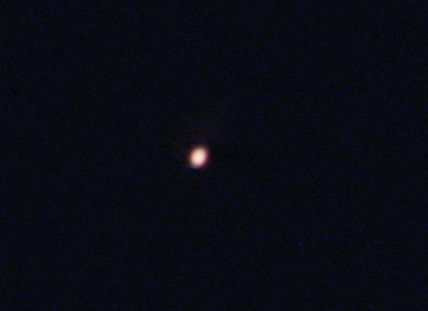
Mercury is an inferior planet, meaning it's orbit lies inside our orbit. The inferior planets show phases, i.e., changes in their apparent shapes, like the moon as they move about the sun. At the time that this image was taken, Mercury was 75% illuminated, and appeared as a magnitude -0.7 point of light in the western sky near Venus. The two planets were only 3 degrees apart, and were drawing closer for a three-way conjunction with the planet Saturn.
The ancients named our innermost planet for the Roman god Mercury, who was the messenger of the gods. This planet moves the most swiftly about the sun of all of the planets in the solar system. A "year" on Mercury is only about 88 Earth days. Mercury orbits slowly, completing a rotation on its axis only one and a half times for each revolution it makes around the sun. Thus, a day on Mercury is equivalent in duration to about 59 Earth days. The surface facing the sun is very hot, reaching temperatures of 400 degrees C (well over 700 degrees F). The dark side away from the sun becomes very cold, with temperatures dropping to -170 degrees C (-274 degess F).
Mercury has almost no atmosphere. It's surface is heavily cratered by meteorite impacts and resembles the surface of our moon. Mercury's diameter is 4,878 kilometers at the equator, as compared to the Earth's 12,756 kilometer diameter. The surface gravity on Mercury is 0.28 times the Earth's gravity. A person who weighed 100 pounds on the Earth would only weigh 28 pounds on Mercury. Jupiter and Saturn each have a moon that is larger than Mercury.
Mercury's orbit is quite eccentric. As a result, the speed of the planet in its orbit varies considerably. The variation in orbital speed would produce some interesting effects if you were on the surface of the planet. In some locations on Mercury's surface, the sun would rise in the east, then stop, back up, and set in the east. The sun would then rise again in the east, move across the sky to the west, set, rise again in the west, then finally set again in the west.
This image was taken with an ST-8XE CCD on a Takahashi Mewlon 210 telescope at prime focus operating at f11.5.
RA: 07h 28m 07s Dec: +23d 19' 00"
June 19, 2005
Image by Sid Leach
Scottsdale, Arizona
Recent Images.
Complete list of images.
Description of equipment used to acquire images.
Home
Feedback and comments should go to Sid